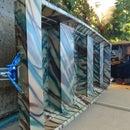Introduction: Easy, Cheap, and Versatile Sanding Blocks
Easy and Cheap Sanding Blocks From Belt Sander Belts and Hardwood
There are a number of great instructables on making sanding blocks. Round, rectangular, quick-release, and with smart hardware better than anything you can buy.
https://www.instructables.com/id/Homemade-Sanding-...
https://www.instructables.com/id/My-Favorite-Sandi...
https://www.instructables.com/id/Make-a-super-chea...
I love all of these, and always draw inspiration from other makers.
But I do think there's an easier way, especially when you might need a 2-in-hand reversible block on the cheap.
Step 1: Sanding Blocks Are Often More Efficient Than Power Tools
Anyone who spends time in a workshop knows the value of sanding blocks. The flatter, harder, and more predictable they are, the better they work on wood, plastic, metal, plaster, drywall, and anything else that needs smoothing or a little careful reduction.
There are many "sanding blocks" available for retail sale. Most of them are made of plastic, or flat plastic, or plastic with wingnuts, or some other kind of plastic. Others are cheap vibrating plastic & metal, mostly good for shaking your hand, ruining your hearing, and taking your money. All of which are designed to grip a sheet, or half sheet, or 1/4 sheet of standard sandpaper.
The alternative is a good block in your hand, heavy enough to help with applying pressure, but light and small enough to hit the details you want without going too far. This instructable is hopefully something that can help craftspeople with making their own sanding blocks and avoiding retail mistakes.
Step 2: The Secret Weapon: Belt Sander Belts
Belt sanders use extremely durable sandpaper in uniform sizes. Most common are 3" x 21" and 3" x 24", and are bonded on cloth rather than paper, and are already wet/dry compatible.
A block of hardwood, cut to 3" wide x 2" less than the nominal belt length, makes a perfect sanding block. It requires almost no hardware, no cuts besides sizing the wood and slitting the belt, is reversible to another grit size, and is easily replaced/repaired.
I mostly use 3" x 24" belts on 22" blocks of wood. I even write the grit # on the sides of the block, so I know what I'm grabbing, and also what I need for replacements.
For any other size sanding belts, just cut your wood to the same width as the belt, and 2-3" shorter than the nominal (closed-loop) length. From this block, you'll get a belt of that size on each side.
Step 3: Cut Out the Splice and Staple the Belt on a Block
Sanding belts are spliced together with a glue joint. You don't want to include this joint in your sanding block because it can make streaks or scratches, it can be unpredictable in your sanding strokes, and its the most likely place for a belt to fail prematurely.
When making a sanding block, cut the splice out and use the rest of the belt. I usually cut as close to the splice as possible while cutting 90* to the belt length, and use that as my starting point. Staple that cut end into the hardwood block and tap in the staples with a tack hammer.
Wrap the belt along the block and fold over the other end. Hit that with a few staples and set them with the light hammer. Then trim off the rest of the splice with a utility knife.
Using belts and blocks in this way allows for different grits on each side, and fast transitions in sanding aggressiveness.
Step 4: Store Your Blocks Flat and They'll Stay Straight
I always keep a few blocks around, with complementary grits of sanding belt on each side. These are great for everything from furniture to surfboards to drywall repairs to prepping metal for paint.
I hope this Instructable was useful!













